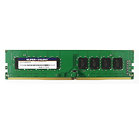Tuesday, November 25th 2014
Super Talent Unveils its DDR4 DRAM Modules
Super Talent Technology, a leading manufacturer of NAND Flash storage solutions, announces line of DDR4 DRAM modules. DDR4 is the successor to DDR3 which is widely used in global enterprise computing solutions. Chip support for DDR4 comes with Intel's next-generation Xeon server processors based on Haswell architecture.
DDR4 provides double the rate of data that DDR3 is able to and allows for increased module densities to provide greater DRAM capacity. In addition, the power usage of these modules is 1.2V compared to DDR3's 1.5V - 20% lower than the previous generation's standard power draw. With lower power usage and higher bandwidth to work with, overhead costs can be reduced while providing increased bandwidth.
DDR4 provides double the rate of data that DDR3 is able to and allows for increased module densities to provide greater DRAM capacity. In addition, the power usage of these modules is 1.2V compared to DDR3's 1.5V - 20% lower than the previous generation's standard power draw. With lower power usage and higher bandwidth to work with, overhead costs can be reduced while providing increased bandwidth.

11 Comments on Super Talent Unveils its DDR4 DRAM Modules
Latency has even less impact on performance than frequency increases once you get above 1600 MHz. on a discrete CPU powered laptop. In addition many people don't understand that the real latency time tends to stay about the same regardless of frequency but the number of clock cycles increases because the actual cycle time decreases as the frequency increases.
Useful reading:
en.wikipedia.org/wiki/DDR3_SDRAM
Overall it doesn't really matter though,...
If you are buying a typical new Haswell-E / EP based Xeon server or workstation you have little to no choice but to go with DDR4,.....for the most part. Also older DDR3 based platforms can't use DDR4. So the merits of which don't really need to be agonized over. Anyone buying such a new DDR4 platform would likely have no real expectations based on the move to DDR4 with specificity or they don't fully understand what they are buying.
Some of AMD's integrated GPU offerings benefit from higher memory bandwidth. I'd be curious to know if they take advantage of the extra speed, although it may be a while before AMD implements it.
Personally I don't really care since I have no vested interest in it either way. However, this is a link to the source I was referring to.
www.anandtech.com/show/8536/intels-haswellep-xeons-with-ddr3-and-ddr4-on-the-horizonAgain, I am not interested in any of this for my use case so I don't really care. I don't look for higher performance from DDR4 with specificity and I don't look to DDR3 for savings on an LGA2011-3 platform. So outside of the scope of those two specific cases,...Pffft,....